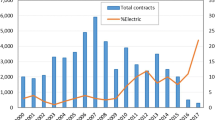Abstract
The present EEDI regulations have a strong impact on ship design. Especially for tankers and bulk carriers, the regulation results in the reduction of the installable main engine power. In 2020, the next EEDI reduction phase is put into force with the consequence that the main engine power of these ships will be reduced even further. The development helps to reduce emissions, especially greenhouse gases, but it puts challenges on ship safety, as the ship must still be maneuverable even in bad weather conditions. Recently, a grounding incident of a bulk carrier sea took place in the German Bight where the ship was dragging its anchor although the main engine was running at full speed. Numerical investigations of this accident showed that the environmental forces acting on the ship were larger than the sum of propeller and anchor forces. This incident was an excellent opportunity to investigate whether our existing numerical calculation methods are able to cope with such kind of incidents and whether it was possible to investigate the root cause of that particular grounding event. The paper gives an overview about the numerical investigations of the grounding event which address course keeping in heavy weather including anchor forces. Additionally, operational aspects of the main engine operation and the propulsion control systems are considered. The ship did not need to comply with the existing EEDI regulations. Therefore, the paper addresses also the effect of reduced main engine power on this particular incident, because it is obvious that reduced main engine power will make such incidents more probable, as limiting environmental conditions for a ship with less power will be less severe and therefore more probable.
Access this chapter
Tax calculation will be finalised at checkout
Purchases are for personal use only
Similar content being viewed by others
References
Augener, P.: Computation of Wave Drift Forces for Dynamic Positioning within the Early Design Stage. Ph.D-Thesis, Hamb. Univ of Techn. (2016)
The Federal Bureau of Marine Casualty Investigations: Report 408/17
Blendermann, W.: Practical Ship and Offshore Areodynamics. Schriftenreihe Schiffbau, Rep. 669. Hamburg (2013)
Isay, W.H.: Propellertheorie. Springer, Heidelberg (1963)
Josten, M.: Trajectory prediction of moored vessels with reduced station capability due to exceeded anchor load limits. In: OMAE, 2019, Glasgow, UK (2019)
Krüger, S.: Maneuvering – which results can be obtained from strip methods? In: Proceedings of JSTG 2018, vol. 108, Hamburg (2018)
Billerbeck, H., Krüger, S., Lübcke A.: Safe maneuvering in adverse weather conditions. In: Proceedings of IMDC 2018, Helsinki, Finland (2018)
Lübcke, A.: Dynamic positioning as a new aspect in the early design stage of ships – calculations, model tests and results. In: Proceedings of JSTG, 2014 vol. 107, Hamburg (2014)
Papanikolau, A., Zaraphonitis, G., Bitner-Gregersen, E., Shigunov, V., EL Moctar, O., Guedes Soares, C., Reddy, D.N., Sprenger, F.: Minimum propulsion and steering requirements for efficient and safe operation (SHOPERA). In: Motorship P&EC Conference, Hamburg, 4–5 March 2015 (2015)
Söding, H.: Body Forces. Manoeuvring Technical Manual. Seehafen Verlag, Hamburg (1993)
Söding, H.: Limits of potential theory in rudder flow predictions. Ship. Techn. Res. 45, 3 (1998)
Vorhölter, H.: Numerische Analyse des Nachstroms und der Propellereffektivität am manövrierenden Schiff. Ph.D-Thesis, Hamb. Univ of Techn. (2011)
Author information
Authors and Affiliations
Corresponding author
Editor information
Editors and Affiliations
Rights and permissions
Copyright information
© 2021 Springer Nature Singapore Pte Ltd.
About this paper
Cite this paper
Krüger, S., Josten, M., Souflis, L. (2021). Safety vs. Sustainability – How Much Underpowering of Ships Is Acceptable?. In: Okada, T., Suzuki, K., Kawamura, Y. (eds) Practical Design of Ships and Other Floating Structures. PRADS 2019. Lecture Notes in Civil Engineering, vol 65. Springer, Singapore. https://doi.org/10.1007/978-981-15-4680-8_31
Download citation
DOI: https://doi.org/10.1007/978-981-15-4680-8_31
Published:
Publisher Name: Springer, Singapore
Print ISBN: 978-981-15-4679-2
Online ISBN: 978-981-15-4680-8
eBook Packages: EngineeringEngineering (R0)




